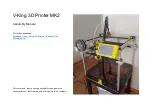
HEALTH AND SAFETY
1-4
20509 Issue 7 Jan 2018
Certain inks are allowed for use where they can be in indirect contact with
food. In these cases, the following precautions must be observed in
addition to those appropriate to hygiene:
• The inks must only be used in printers supplied from new for use with
these inks. Any repairs and replacements must use genuine, new and
unused spare parts.
• The inks must not be used in printers which have previously been
used, at any time, for any other purpose.
Storage
Printing inks must be stored in well-ventilated buildings, in areas set aside
for the purpose, chosen for safety in case of fire. Materials based on
volatile, flammable solvents must be stored in accordance with local
regulations.
Fire Risk
For an electrical fire, do not use water. If water must be used, such as in
the case of a Nitro-cellulose ink fire (see below) the power MUST BE
REMOVED first.
Many inks contain Nitro-cellulose as the binder and remain highly
flammable when dry. Observe all warnings given on the machine and the
following safety instructions:
• If there has been an accumulation of dried ink, do not use metal
scrapers to remove it, as they can produce sparks.
• If dry Nitro-cellulose based ink ignites, it will generate its own oxygen
and can only be extinguished by lowering the temperature with water.
• If a Nitro-cellulose fire occurs, ENSURE THAT THE ELECTRICAL
POWER IS IMMEDIATELY REMOVED FROM THE PRINTER BEFORE
water is used to extinguish the fire.
Fire risk is a most important consideration where printing inks are stored
and used. The degree of fire hazard will vary considerably from one type of
ink or wash to another.
Water-based inks will not burn, although inks based on water-alcohol
mixtures may burn if there is sufficient alcohol present. Prolonged exposure
of water-based systems to high temperatures may evaporate the water to
give a flammable residue.
Solvent-based inks offer a greater degree of hazard depending on the
particular solvent or solvent combination. When there is a particular hazard
the appropriate information is given on the SDS.
During maintenance, print drops may be collected in a container, such as a
beaker. It is essential that this container is made of conducting material and
is securely connected to ground/earth.
If there is a fire, there is a likelihood that dangerous fumes will arise from
printing inks. For this reason ink must be stored where it can be reached
Содержание Macrojet 2
Страница 1: ...Domino Macrojet 2 Product Manual ...
Страница 2: ... 2 20509 Issue 7 Jan 2018 THIS PAGE INTENTIONALLY LEFT BLANK ...
Страница 5: ...20509 Issue 7 Jan 2018 5 ...
Страница 10: ...HEALTH AND SAFETY 1 2 20509 Issue 7 Jan 2018 THIS PAGE INTENTIONALLY LEFT BLANK ...
Страница 14: ...HEALTH AND SAFETY 1 6 20509 Issue 7 Jan 2018 THIS PAGE INTENTIONALLY LEFT BLANK ...
Страница 16: ...DESCRIPTION 2 2 20509 Issue 7 Jan 2018 This page intentionally left blank ...
Страница 38: ...DESCRIPTION 2 24 20509 Issue 7 Jan 2018 THIS PAGE INTENTIONALLY LEFT BLANK ...
Страница 40: ...MAINTENANCE PROCEDURES 3 2 20509 Issue 7 Jan 2018 THIS PAGE INTENTIONALLY LEFT BLANK ...
Страница 52: ...MAINTENANCE PROCEDURES 3 14 20509 Issue 7 Jan 2018 THIS PAGE INTENTIONALLY LEFT BLANK ...
Страница 66: ...FAULT FINDING AND REPAIR 4 14 20509 Issue 7 Jan 2018 Solenoid Connections ...
Страница 94: ...INSTALLATION A 2 20509 Issue 7 Jan 2018 THIS PAGE INTENTIONALLY LEFT BLANK ...
Страница 114: ...INSTALLATION A 22 20509 Issue 7 Jan 2018 THIS PAGE INTENTIONALLY LEFT BLANK ...













































